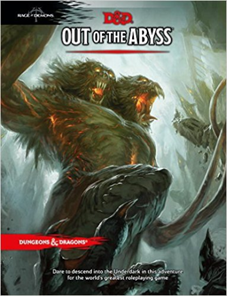 The second half of Out of the Abyss is taking my group a little longer to complete than I first thought. There are some tremendously difficult encounters in the adventure, especially if the group hasn’t worked out how to tackle them. An encounter with a beholder left two of the group petrified, one dead, one fell into a chasm, another was charmed, and the last fled (due to a fear effect). Only the fact that they had allies that could unpetrified and raise the dead allowed the group to continue…
The second half of Out of the Abyss is taking my group a little longer to complete than I first thought. There are some tremendously difficult encounters in the adventure, especially if the group hasn’t worked out how to tackle them. An encounter with a beholder left two of the group petrified, one dead, one fell into a chasm, another was charmed, and the last fled (due to a fear effect). Only the fact that they had allies that could unpetrified and raise the dead allowed the group to continue…
I didn’t run the group through the first half of the adventure – they came to Out of the Abyss direct from completing Curse of Strahd, so all of the encounters in the first half are able to be repurposed for reuse now. So, with the group needing the eye of a beholder – and not particularly game for returning to the beholder that wrecked them – I invented an auction for a beholder eye at Blingdenstone. Of course, now the players have travelled there, they’ve discovered Blingdenstone has an ooze problem, and the group is travelling to Neverlight Grove to get some supplies to deal with the oozes. Of course, Neverlight Grove will have its own problems the players need to solve…
All of this requires a lot of travelling. There are extensive random encounter tables in Out of the Abyss, and I’ve been happily using them to generate the dangers the party encounter in the passages. This is tremendously important to generate XP for the party – as I’m not using the milestone rules. If you’re using Out of the Abyss without the milestones, just the set encounter areas do not give enough XP to get to the levels you need.
However, just running a monster encounter in a 10-foot-wide tunnel tends to be an unexciting affair, with no opportunities for manoeuvre. So, I’ve been using the battlemat and miniatures a lot more with this section of the dungeon, and drawing interesting tunnel and cavern set-ups to challenge the party. Caverns with pillars, stalactites and stalagmites to hide behind. A honeycomb of interlocking tunnels. Pits, lava flows and unstable ground… all making the fight more than just standing toe-to-toe with the enemies.
Varying the approach direction and timing of the monsters also increases the interest. In an encounter I ran last night, the group were attacked by two trolls. After they were slain, they immediately announced they were looting the bodies… which is when the next two trolls attacked (with surprise, as no-one was keeping watch). I was rather surprised to discover that they didn’t learn their lesson after the second fight, and went to loot again without checking to see if there were any more monsters about… so, of course, that’s when the final two trolls attacked. The wizard, sick of this, then cast wall of fire to extend down the corridor the trolls were coming from – alas, after all the trolls were slain!
Some “monsters” are friendly, some are treacherous. You need to vary the situations. It’s not hard to draw a different lay-out for a battle if you use a grid, and each encounter gives a different feel.
One of the biggest tricks in my toolbox is that I’m not bound by the roll of the dice. I’m quite happy to overrule what they say – or not roll them at all – and choose results that will make the next encounter interesting. 1d4 Vrocks? Well, the party had no trouble at all killing two Vrocks, so let’s send them against four of the vulture-demons. And let’s have them on a high ledge above the party, dive-bombing the back of the party with surprise…
A terrain roll indicates green slime? Let’s have the centre of the cavern be a thin rock crust over a pool of Green Slime, and let’s have the Hook Horrors grab the party members and throw them into the slime! This provides enough of the unusual to keep the players intrigued.
For even more fun, have the group run into a fight between two forces! Who will they aid? Will their allies be trustworthy or will they turn on the party? Or will both warring groups join together against the adventurers?
There’s so much you can do to liven up encounters, and all the things you can do with set encounters, you can also do with random encounters. If you’re not quick at improvising at the table, write down a few elements that you can draw from when an encounter occurs… just to change things up and perplex (and entertain) your players!
